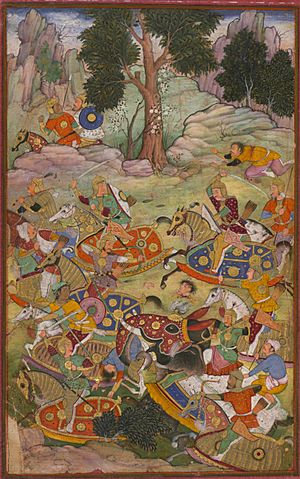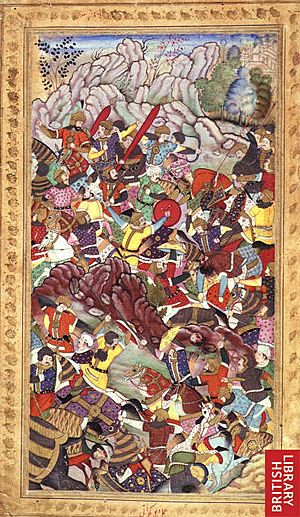First Battle of Panipat facts for kids
Quick facts for kids First Battle of Panipat |
|||||||||
|---|---|---|---|---|---|---|---|---|---|
| Part of Mughal conquests | |||||||||
 The battle of Panipat and the death of Sultan Ibrāhīm |
|||||||||
|
|||||||||
| Belligerents | |||||||||
| Commanders and leaders | |||||||||
| Strength | |||||||||
| 12,000–25,000 soldiers 15–20 field guns |
20,000 regular cavalry 20,000 irregular cavalry 30,000 infantry armed with swords, pikes, bows and bamboo rods 1,000 elephants |
||||||||
| Casualties and losses | |||||||||
| Unknown | 6,000 killed in battle thousands killed while retreating |
||||||||
The First Battle of Panipat was a very important fight in Indian history. It happened on April 20, 1526, near Panipat, India. This battle was between the army of Babur, who was an invader, and the army of Ibrahim Lodi, the ruler of the Delhi Sultanate.
This battle was special because it was one of the first times gunpowder weapons and field artillery (cannons) were used in India. Babur's forces brought these new technologies. His victory marked the start of the powerful Mughal Empire in India. It also meant the end of the Lodi dynasty and the Delhi Sultanate. The Mughal Empire then ruled India for over 200 years.
Contents
Why the Battle Happened
Babur had lost control of his lands in Samarkand twice. So, he decided to focus on conquering Hindustan (India). By 1519, he had reached the Chenab river. At first, he only wanted to take over Punjab. He felt it was his right because his ancestor, Timur, had once ruled there.
At this time, much of North India was under Ibrahim Lodi's rule. But his empire was weak, and many local leaders were unhappy. Babur received invitations from people like Daulat Khan Lodi, who was the Governor of Punjab, and Ala-ud-Din, Ibrahim Lodi's uncle. They wanted Babur to come and defeat Ibrahim.
Babur sent a messenger to Ibrahim Lodi. He claimed he was the rightful ruler of the land. However, Ibrahim Lodi had the messenger arrested. This made Babur even more determined.
In 1524, Babur marched towards Lahore, Punjab. He found that Ibrahim Lodi's forces had already driven out Daulat Khan Lodi. Babur's army defeated Lodi's army in Lahore. After this, Babur burned Lahore for two days. He then went to Dipalpur and put Alam Khan, another rebel uncle of Lodi, in charge. But Alam Khan was quickly defeated and ran away to Kabul. Babur gave Alam Khan more troops, and he joined with Daulat Khan Lodi. Together, they tried to attack Ibrahim Lodi in Delhi with about 30,000 soldiers. Ibrahim Lodi defeated them. Babur then realized that Lodi would not let him simply take over Punjab. He knew he had to fight a big battle to win.
How the Battle Was Fought
When Ibrahim Lodi's huge army arrived at Panipat, Babur was ready. He had planned his defense carefully. He protected his right side by placing it against the city of Panipat. On his left side, he dug a long trench and covered it with tree branches. This made it hard for the enemy to attack from there.
In the middle of his army, Babur placed about 700 carts. He tied these carts together with ropes. Between every two carts, he built small walls. These walls protected his soldiers who used matchlock guns. Babur made sure there was enough space for his soldiers to aim and fire their guns. He called this strategy the "Ottoman device." The Ottomans had used a similar method before.
When Ibrahim Lodi's army tried to attack, they found the path to Babur's army was too narrow. They had to stop and rearrange their soldiers to fit. Babur quickly saw this chance. He used a tactic called tulghuma, which meant surrounding the enemy. His soldiers moved around the sides of Lodi's army.
Many of Ibrahim Lodi's soldiers couldn't even get into the fight. They fled when they saw the battle turning against them. Ibrahim Lodi himself was killed while trying to escape. About 20,000 of his soldiers died in the battle.
Cannons and Clever Tactics
Babur's cannons were a huge advantage. Ibrahim Lodi did not have any cannons. The loud noise of Babur's cannons scared Ibrahim's elephants. The frightened elephants then ran backward, trampling their own soldiers.
Babur used two main tactics: tulghuma and araba.
- Tulghuma meant dividing his army into different groups: Left, Right, and Center. Each of these was further split into front and back parts. This allowed a smaller army to surround a larger enemy from all sides.
- Araba referred to the carts used in the center. These carts were placed in rows facing the enemy and tied together with animal hide ropes. Behind the carts, cannons were placed. These cannons were protected by movable shields called mantlets. This setup allowed Babur's cannons to fire safely without fear of being hit. The cannons could also be easily moved to aim at new targets because the mantlets had wheels. These clever tactics made Babur's artillery very deadly.
What Happened After Ibrahim Lodi Died
Ibrahim Lodi died on the battlefield, along with 20,000 of his soldiers. The Battle of Panipat was a clear military victory for Babur's forces.
Politically, this victory gave Babur new lands. It started a new chapter in India's history: the establishment of the long-lasting Mughal Empire. This empire ruled the heart of the Indian subcontinent for over 300 years, changing India forever.
See also
 In Spanish: Batalla de Panipat (1526) para niños
In Spanish: Batalla de Panipat (1526) para niños
- Battle of Hisar Firoza
- Battle of Khanwa
- Second Battle of Panipat
- Third Battle of Panipat
- Battle of Ghaghra
- Wagon fort
Sources



